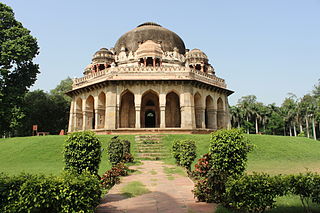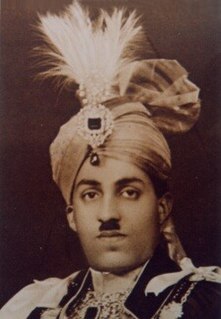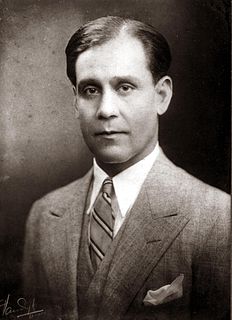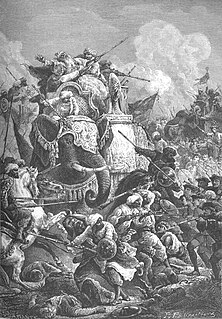
Mir Qamar-ud-din Khan Siddiqi Bayafandi was a nobleman of Indian and Turkic descent and the founder of the Asaf Jahi dynasty. He established the Hyderabad state, and ruled it from 1724 to 1748. He is also known by his titles Chin Qilich Khan, Nizam-ul-Mulk and Asaf Jah.

The Sayyid dynasty was the fourth dynasty of the Delhi Sultanate, with four rulers ruling from 1414 to 1451. Founded by Khizr Khan a former governor of Multan, they succeeded the Tughlaq dynasty and ruled the sultanate until they were displaced by the Lodi dynasty. Members of the dynasty derived their title, Sayyid, or the descendants of the Islamic prophet, Muhammad, based on the claim that they belonged to his lineage through his daughter Fatima, and son-in-law and cousin Ali.

The Nizam of Hyderabad was a monarch of the Hyderabad State, now divided into Telangana state, Hyderabad-Karnataka region of Karnataka and Marathwada region of Maharashtra. Nizam, shortened from Nizam-ul-Mulk, meaning Administrator of the Realm, the title of the rulers of Hyderabad State, was the premier Prince of India, since 1724, belonging to the Asaf Jahi dynasty.

General Nawab Sir Sadiq Muhammad Khan V Abbasi was the Nawab, and later Amir, of Bahawalpur State from 1907 to 1966. He became the Nawab on the death of his father, when he was only three years old. A Council of Regency, with Sir Rahim Bakhsh as its President, ruled on his behalf until 1924.

Ahmad Shah Bahadur, also known as Mirza Ahmad Shah or Mujahid-ud-Din Ahmad Shah Ghazi was born to Mughal Emperor Muhammad Shah. He succeeded his father to the throne as the 13th Mughal Emperor in 1748 at the age of 22. When Ahmed Shah Bahadur came to power the Mughal Empire was collapsing, furthermore his administrative weaknesses eventually led to the rise of the usurping Feroze Jung III.
Khan Umara Khan of Jandul, also called "Napoleon of Pathans", was a Pashtun chief on the north-western frontier of British India, who was chiefly responsible for the Chitral Expedition of 1895.

Chitral was a princely state in alliance with British India until 1947, then a princely state of Pakistan until 1969. The area of the state now forms the Chitral District of the Malakand Division, Khyber-Pakhtunkhwa, Pakistan.
Mir Ahmed Ali Khan Siddiqi Bayafandi, Nasir Jung, was the son of Nizam-ul-Mulk by his wife Saeed-un-nisa Begum. He was born 26 February 1712. He succeeded his father as the Nizam of Hyderabad State in 1748. He had taken up a very pompous title of Humayun Jah, Nizam ud-Daula, Nawab Mir Ahmad Ali Khan Siddiqi Bahadur, Nasir Jung, Nawab Subadar of the Deccan. However, he is most famously known as Nasir Jung.

Nawabs of the Carnatic ruled the Carnatic region of South India between about 1690 and 1801. The Carnatic was a dependency of Hyderabad Deccan, and was under the legal purview of the Nizam of Hyderabad, until their demise. They initially had their capital at Arcot in the present-day Indian state of Tamil Nadu. Their rule is an important period in the history of Carnatic and Coromandel regions, in which the Mughal Empire gave way to the rising influence of the Maratha Empire, and later the emergence of the British Raj.

Muhammad Ali Khan Wallajah, or Muhammad Ali Khan Walla Jah, was the Nawab of Arcot in India and an ally of the British East India Company. Muhammad Ali Khan Wallajah was born to Anwaruddin Muhammed Khan, by his second wife, Fakhr un-nisa Begum Sahiba, a niece of Sayyid Ali Khan Safavi ul-Mosawi of Persia, sometime Naib suba of Trichonopoly, on 7 July 1717 at Delhi. Muhammed Ali Khan Wallajah the Nawab of Arcot often referred to himself as the Subedar of the Carnatic in his letters and correspondence with the then Mughal Emperor Shah Alam II.
Sa'adatullah Khan II a.k.a. Muhammad Sayyid was Nawab of Arcot, who was a younger son of Safdar Ali Khan.

Anwaruddin Khan, a.k.a. Muhammad Anwaruddin, was the 1st Nawab of Arcot of the second Dynasty. He was a major figure during the first two Carnatic Wars. He was also Subehdar of Thatta(Pakistan) from 1721-1733.

Hajji Nawab Hafiz Sir Hamidullah Khan was the last ruling Nawab of Bhopal, which merged with the state of Madhya Pradesh in 1956. He ruled from 1926 when his mother, Begum Kaikhusrau Jahan Begum, abdicated in his favor, until 1949 and held the honorific title until his death in 1960. A delegate to the Round Table Conference in London, he served as Chancellor of the Chamber of Princes from 1944–1947, when India became independent. During the Second World War, Nawab Hamidullah Khan was present at the Battle of Keren and the Battle of El Alamein. Nawab Hamidullah, as he was popularly known was very close to Muhammad Ali Jinnah, the founder of Pakistan. He also had very good terms with Louis Mountbatten, Viceroy and Governor General of India. In spite of pressure from Jinnah, he reluctantly agreed to have Bhopal as a part of Indian Union. At his death, he left no sons and so was succeeded by his second daughter, Sajida Sultan, Begum of Bhopal.
Nawab Muhammad Mushtaq Ali Khan Bahadur, was a Nawab of the princely state of Rampur from 1887 to 1889, succeeding his father Sir Nawab Kalb Ali Khan Bahadur. Owing to continued ill-health, he was unable to properly rule the state and so left its affairs in the hand of an administrative council. However, he was successful in continuing the beneficiaries of his predecessors, particularly in the areas of agriculture and irrigation. He died at the age of 32 in 1889 and was succeeded by his son, Sir Hamid Ali Khan Bahadur.

Nawab Sayyid Hamid Ali Khan Bahadur GCSI GCVO GCIE was Nawab of the princely state of Rampur from 1889 to 1930.
Khan Bahadur Sir Ghulam Muhammad Ali Khan (1882–1952) was the fifth Prince of Arcot and ruled from 1903 to 1952.

Nawab Ghazi ud-Din Khan Feroze Jung III, Feroze Jung III, or Imad-ul-Mulk, was a mid-18th-century kingmaker during the Mughal Empire. He was the son of Ghazi ud-Din Khan Feroze Jung II. His original name was Shahabuddin Muhammad Feroz Khan Siddiqi Bayafandi. After the death of his father in 1752, he was recommended by Nawab Safdar Jung to be appointed as Mir Bakhshi and received the titles of Amir ul-Umara and Imad ul-Mulk by the Mughal Emperor Ahmad Shah Bahadur of Delhi. He was also The Subehdar of Assam until 1782.
Intizam-ud-Daula, Ghazi Ud-Din Khan Siddiqi Bayafandi Feroze Jung II was the eldest son of Asaf Jah I Mir Qamaruddin Khan Siddiqi. He was born on 13 March 1709, his mother is Saidunisa Begum. He died in Aurnagabad on 16 October 1752.

The Battle of Ambur was the first major battle of the Second Carnatic War.














